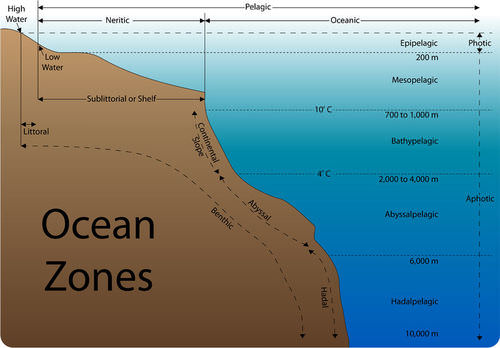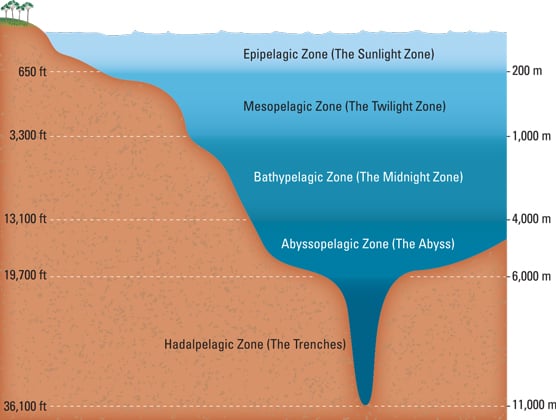What Three Zones Are Used to Describe Water's Depth
Deep Marginal Pond Plants. Equal to 325851 gallons or 1233 cubic meters.

Ocean Zones Read Earth Science Ck 12 Foundation
Preparation of a water-table.

. All pores at the soil surface are filled with water before water can begin to move downward. Within the deep zone the temperature decreases slightly. A shallow surface mixed zone a transition zone and a deep zone.
Data is revised every 5 years. The three largest water-use categories were irrigation 118 Bgalday thermoelectric. Concepts of Ground Water Water Table and Flow Systems Subsurface Water Water beneath the land surface occurs in two principal zones the unsaturated zone and the saturated zone Figure A-1.
500 to 3280 ft below the sea surface. Label the cone of depression on Figure 8130. Oceanographers generally recognize a three-layered structure in most parts of the open ocean.
These zones differ from an aquifer. In the unsaturated zone the voids--that is the spaces between grains of gravel sand silt clay and cracks within rocks--contain both air and water. Maximum see sequence of wells in Annex D-1 Extension Period.
The interface between these two zones is called the wetting front. A small pond may consist entirely of littoral zone. Epipelagic Mesopelagic Bathypelagic Abyssopelagic Hadopelagic.
The ocean is divided into different depth zones. Shallow water - the first fathom from 0 to 6 feet deep Mid-depth - from 6 to 12 feet deep Deep water - from 12 to 18 feet deep or three fathoms These three vertical zones exist for me even over 100 feet of water. During infiltration water moves downward from the saturated zone to the unsaturated zone.
The upper surface of the saturated zone is called the water table. The aphotic zone is further subdivided into the bathypelagic zone or midnight zone between 1000 and 4000 meters 3280 and 13123 feet the abyssopelagic or the abyss between 4000 and 6000 meters 13123 and 19685 feet and the hadopelagic zone or hadal zone 6000 meters 19685 feet and deeper. Acre-foot acre-ft--the volume of water required to cover 1 acre of land 43560 square feet to a depth of 1 foot.
They are typically found growing in water that is between 6-16 15 cm-40 cm. Littoral limnetic and pro-fundal. THE WATER TABLE The depth to the water table can be determined by installing wells that penetrate the top of the saturated zone just far enough to hold standing water.
20000 to 35000 ft below the sea surface. I divide any and all water into these three zones. Remember this cannot be found in the polar.
Major zones in the oceans Intertidal zone The intertidal zone is the area of the seafloor between high tide and low tide. Water quality--a term used to describe the chemical physical. But are not totally saturated with water.
Water depth means the depth as measured from the water level to the bottom of a public swimming pool. And the deep zone contains cold high-density water that accounts for 80 percent of. The epipelagic extends from the water surface down to a depth of 200 metres.
This zone contains all the habitats of the sea bottom whether in coastal. Lentic waters are generally divided into three zones or sub-habitats. However a deep lake with an abruptly sloping basin may possess an extremely reduced littoral zone.
As of 2015 the United States uses 322 billion gallons of water per day Bgalday. Depth Zone Depth m Pressure Range atm Average Temperature ºC Light Intensity. Water moves because of water potential gradients in the soil caused mostly by gravity salt content and water usage and the direction of flow is from a zone of.
The deep zone is an area of very cold water that extends from the bottom of the thermocline to depths of 4000 meters or more. Depth zones of the ocean. The main zones in the ocean depth-wise are 1 a near-surface mixed layer in which the temperature is nearly constant 2 a thermocline layer in which the temperature decreases with depth and 3 the deep layer where the temperature.
Maximum D-14 DRILLING DEPTH. Describe the shape of the water table in relationship to the shape of the land surface. Describe the three zones of a lake.
In most cases these plants are quite tall allowing them to keep their leaves above the water line. Whenever a substantial amount of water is withdrawn from a well the water table forms a cone of depression. This upper layer which is influenced by light is especially productive because the primary producers algae cyanobacteria and seagrass.
The shallow zoneAt shore open water zonelocated away from shore and deep water zonebelow the open water zone. There are three main layers in the ocean based on water density which varies with temperature and salinity. Deep Marginal Pond Plants are similar to marginal plants except they have adapted to living in deeper water.
This zone is further subdivided by depth as follows. The warm surface mixes layer accounts for only 2 percent of ocean water. So its temperature is above freezing.
13000 to 20000 ft below the sea surface Hadal zone. When precipitation or irrigation cease gravitational water. The transition zone includes the thermocline and the pycnocline and accounts for 18 percent of ocean water.
Soil water is used by plants in life functions and transpiration but it also can evaporate directly to the atmosphere. The word comes from the Greek terms pélagos open sea and epí upon. These zones contain the largest ecosystem on Earth.
3280 to 13000 ft below the sea surface Abyssopelagic zone. Th depth of more than 1500 meters the temperature is about 4 degree celsius. Water in the form of precipitation or irrigation infiltrates the soil surface.
There are four major oceanic zones where plants and animals live in the ocean. Based on 2 documents. Contrary to popular belief groundwater does not form underground rivers.
Label the zone of saturation the unsaturated zone and the water table. The four major zones are intertidal zone neritic zone open ocean zone and benthic zone. The shallow zoneAt shore open water zonelocated away from shore and deep water zonebelow the open water zone.
Summary of depth zones. This article throws light upon the three main types of movement of water in soil.


0 Response to "What Three Zones Are Used to Describe Water's Depth"
Post a Comment